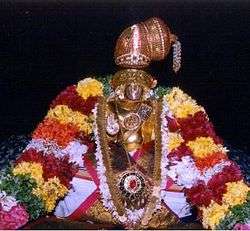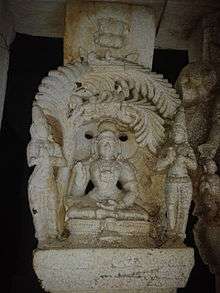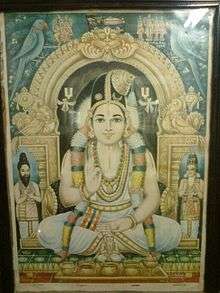Nammalvar
Nammazhwar (Tamil: நம்மாழ்வார்) is one of the twelve alwar saints of Tamil Nadu, India, who are known for their affiliation to the Vaishnava tradition of Hinduism. The verses of alwars are compiled as Nalayira Divya Prabandham and the 108 temples are classified as Divya Desam. Nammalwar is considered the fifth in the line of the twelve alwars. He is highly regarded as a great mystic of the Vaishnava tradition. He is also considered the greatest among the twelve alwars and his contributions amount to 1352 among the 4000 stanzas in the Nalayira Divya Prabandam.
Nammalvar | |
|---|---|
.jpg) Stucco image of Nammazhwar in Kalamegha Perumal temple | |
| Personal | |
| Born | 798 CE[1] |
| Religion | Hinduism |
| Philosophy | Vaishnava Bhakti |
| Religious career | |
| Literary works | Thiru Virutham, Thiru Vaasiriyam, Periya Thiru Andaathi, Thiruvaimozhi |
| Honors | Alwar saint |
| Part of a series on |
| Vaishnavism |
|---|
 |
|
Holy scriptures
|
|
Sampradayas
|
|
Related traditions |
|
|
According to traditional scriptures, Nammalwar was born in 3059 BCE in Alwarthirunagiri.[2] In Hindu legend, Nammalwar remained speechless from his birth sitting in a tamarind tree and he first interacted with Madhurakavi Alvar, who saw a bright light shining to the south, and followed it until he reached the tree where the boy was residing.
The works of Nammalwar were compiled by Madhurakavi as four different works, the Tiruvayumoli (1102 verses), Thiruviruttam (100 verses), Thiruvaasiriam (or Thiru Aasiriyam - 7 verses) and Periya Thiruvanthadi (87 verses). The works of Nammalwar contributed to the philosophical and theological ideas of Vaishnavism.
The Garudasevai festival in Nava Tirupathi, the nine Vishnu temples in Thoothukudi region and the Araiyar Sevai during the Vaikunta Ekadesi festival in Srirangam temple are dedicated to him. The verses of Nammalwar and other alwars are recited as a part of daily prayers and during festive occasions in most Vishnu temples in South India.
Alwars

The word alwar means the one who dives deep into the ocean of the countless attributes of god.[3] The Alwars are considered the twelve supreme devotees of Vishnu who were instrumental in popularising Vaishnavism. The religious works of these saints in Tamil, songs of love and devotion, are compiled as Nalayira Divya Prabandham containing 4000 verses and the 108 temples revered in their songs are classified as Divya Desam.[4][5] The saints had different origins and belonged to different castes. As per tradition, the first three alwars, Poigai Azhwar, Bhoothath Azhwar and Pey Azhwar were born miraculously. Thirumalisai Alvar was the son of a sage, Thondaradippodi Alvar, Madhurakavi Alvar, Periyalvar and Andal were from the Brahmin community, Kulashekhara Alwar a kshatriya, Nammalwar a Vellala, Thiruppaan Alvar a paanar and Thirumangai Alvar a kallar. The Divya Suri Charitra by Garuda-Vahana Pandita (11th century), Guruparamparaprabhavam by Pinbaragiya Perumal Jiyar, Periya tiru mudi adaivu by Anbillai Kandadiappan, Yatindra Pranava Prabavam by Pillai Lokacharya, commentaries on Divya Prabandam, Guru Parampara (lineage of Gurus) texts, temple records and inscriptions give a detailed account of the alwars and their works. According to these texts, the saints were considered incarnations of some form of Vishnu. Poigai is considered an incarnation of Panchajanya (Krishna's conch), Bhoothath of Kaumodakee (Vishnu's Mace/Club), Pey of Nandaka (Vishnu's sword), Thirumalisai of Sudarshanam (Vishnu's discus), Namm of Vishvaksena (Vishnu's commander), Madhurakavi of Vainatheya (Vishnu's eagle, Garuda), Kulasekhara of Kaustubha (Vishnu's necklace), Periya of Garuda (Vishnu's eagle), Andal of Bhoodevi (Vishnu's wife, Lakshmi, in her form as Bhudevi), Thondaradippodi of Vanamaalai (Vishnu's garland), Thiruppaan of Srivatsa (An auspicious mark on Vishnu's chest) and Thirumangai of Sharanga, Rama's bow. The songs of Prabandam are regularly sung in all the Vishnu temples of South India daily and also during festivals.[5][6]
According to a traditional account by Manavala Mamunigal, the first three alwars, namely Poigai, Bhoothath and Pey, belong to the Dvapara Yuga (before 4200 BC). It is widely accepted by tradition and historians that the trio are the earliest among the twelve alwars.[4][5][7][8][9] The alwars were also instrumental in promoting the Bhagavatha cult and the two epics of India, the Ramayana and the Mahabharata.[10] The alwars were instrumental in spreading Vaishnavism throughout the region.[11] The verses of the various alwars were compiled by Nathamuni (824-924 AD), a 10th-century Vaishnava theologian, who called it the "Tamil Veda".[12][13]

Early life
According to traditional scriptures, Nammalwar was born on the 43rd Kali in 3059 BC.[2] He was born at Thirukurukur (modern day Alwarthirunagiri) in the southernmost region of the Tamil country.[14][15] Some sources consider his to have been a princely family, although of shudra status (To prove world that "caste is not based on birth and it is based on action").[14][16][17]
Tradition says that he must have been born fully enlightened because as a baby he never cried or suckled and never opened his eyes. According to legend, as a child he responded to no external stimuli and his parents left him at the feet of the deity of Sri Adhinathar in Alwarthirunagari. The child then got up and climbed into a hole in a tamarind, sat in the lotus position, and began to meditate. It appears he was in this state for as long as sixteen years when a Tamil poet and scholar in named Madhurakavi Alvar was born in Thirukolur and had travelled to North India on a temple trip. As he was performing his Nitya Anushtanam one day, he saw a bright light shining to the south, and followed it until he reached the tree where the boy was residing. Unable to elicit any reaction from the child, he asked him a riddle: "If the small is born in a dead's body (or stomach), what will it eat and where will it stay?" meaning, if the subtle soul is embodied in the gross body, what are its actions and thoughts? Nammalwar broke his lifelong silence and responded, "That it will eat, it will rest!" meaning that if the soul identifies with the body, it will be the body but if it serves the divine, it will stay in vaikunta and eat(think) of God.[18] Madhurakavi Alvar realized the divinity of this child.
It is believed that in the Kali yuga, the doors of vaikuntam (the supreme abode) was opened first time for him by Sriman Narayanan himself and it is believed that the followers of Swami Nammalwar have the most easy access to the supreme abode. Following his moksha his family entitle as the subbiah kumara pillai (the auspicious son's) by holy Vaishnava acharya's and they serve him and believe him to be Sriman Narayanan Tiruvadi and celebrate him as kulaguru.
Nammalwar was one of the twelve alwar poet-saints who immersed themselves in a love of Vishnu and who had a considerable knowledge of ancient Tamil literature and its variants of traditional stories concerning Vishnu and his associates, as well as the philosophical differences between Buddhism, Hinduism and Jainism.[15]
Madhurakavi Alvar was his first disciple. Swami Madhurakavi Alvar composed 11 pasurams in praise of his Acharya, Swami Nammalwar known as Kanninun Shiruthambu, which are included among the 4000 Nalayira Divya Prabandham.

Work
He contributed four pieces of works to Divya Prabhandham. These works consisted of 1,296 poems, making him the most prolific contributor to the 4,000 hymns written by the Alvar poet-saints.[14] These works are:
- Thiruvaymoli (1102 verses)
- Thiruviruttam (100 verses)
- Thiru Vaasiriam (7 verses)
- Periya Thiruvanthadi (87 verses)
Tiruvaymoli describes Ranganatha as a metaphor for discussing the philosophical details in
- The nature of the paramatma (divine soul)
- The nature of the jeevatma (living soul)
- The means for the jeevatma (living soul) to attain the goal of Paramatma (divine soul)
- The blocks and hurdles on the way and
- The goal moksha (divinity).
In the Srivaishnava canon, these four represent (in Tamil language) the four Sanskrit vedas, respectively, the Sama Veda, Rig Veda, Yajur Veda and Atharva Veda. According to tradition "He poured the cream of these vedas" into his songs and poetry that were the result of deep mystic experience. Though Nammalwar did not visit any of the 108 divyadesam temples talked about in the Vaishnava religion, it appears from his works he must have had the vision of all the archa forms in the temples he glorified in his hymns.[19]
Style of composition
The distinction of Nammalwar with his contemporaries is above the devotional aspects in writing, the visualization and dramatic movement. He mentions Vishnu in various aspects frequently in all his verses. The poems of Tiruvirrutam are depicted fully between the lone context of the hero and heroine. Most of these are utterances of the hero, heroine, her friends to the heroine or her mother to the heroine. The heroine always perceives his hero, Vishnu everywhere around her. As per Varadachari, Tiruviruttam is "an account of the pilgrimage of the soul to its transcendence over its ignorance, sleep and sloth in which it is caught up in the body". While the medieval poetry is considered self-pity and repentance, his works always have a message of hope.[20]
Culture
Nammalwar is regarded as the one of the top three Hindu mystics in India, with the other two being Manickavasagar and Kabir.[21] Nammalwar is considered greatest among the twelve alwars and his contributions amount to 1352 among the 4000 stanzas in the Nalayira Divya Prabandam.
The Garuda Sevai utsavam (festival) in the month of Vaikasi(May-Jun) witnesses nine Garudasevai, an event in which festival image idols from the nava tirupathis temples namely, Mayakoothar Temple, Makara Nedunkuzhai Kannan Temple, Rettai Tirupathi - South Temple, Rettai Tirupathi North Temple, Vaithamanidhi Perumal Temple, Adhinaatha Perumal Temple - Thirukkurugur, Kaaisinavendhan Temple, Vijayaasana Perumal Temple, Sri Vaikuntanatha(Kallapiran) Temple are brought on Garuda vahana. The festival image of Nammalvar is also brought in Anna Vahanam (palanquin) and his verses dedicated to each of these nine temples are recited. The utsavar of Nammalvar is taken in a palanquin to each of the nine temples, through the paddy fields in the area. The verses dedicated to each of the nine Divyadesams are chanted in the respective shrines. It is the most important of the festivals in this area, and it draws thousands of visitors.[22]
Pagal Pathu(10 day time) and Ra Pathu(10 day night time) festival are celebrated in the month of Margazhi(December–January) for twenty days in Sri Ranganathaswamy Temple, Srirangam. The first ten days are referred as Pagal-Pathu (10 day day festival) and the second half as Ra Pathu(10 day night time festival). The first day of Ra pathu is Vaikunta Ekadashi. The eleventh day of each fortnight in Tamil calendar is called ekadesi and the holiest of all ekadasis in the Vaishnava tradition is the Vaikunta Ekadashi. Nammalwar, one of the 12 alwars, is believed to have ascended to vaikuntam(the heavenly abode of Vishnu) on this day. The devotion of the 9th-century poet, Nammalwar, and his perceived ascent to heaven are enacted annually. During the festival, through song and dance, this place is affirmed to be Bhoologa Vaikunta(heaven on earth).[23] Araiyar Sevai is a divine colloquim of araiyars, who recite and enact Nalayara Divya Prabanda, the 4000 verses of alwars (Vaishnavite poets of the 7th–10th century).[24][25] Araiyars are born to Araiyar tradition most prevalent in Sri Vaishnava families in Srirangam, Alwar Thirunagari and Srivilliputhur.[24] The tradition of Araiyar Sevai was started by Nathamuni, a 10th-century Vaishnavite who compiled the works of alwars.[25] It is believed as per Hindu mythology that 330 million demi-gods came down to witness the event.[26] The festival deity is brought to the 1000-pillared hall on the morning of Vaikunta Ekadashi through the Paramapada Vasal (gate to paradise). Lakhs of pilgrims rush to enter it after the gate is opened and the deity passes through it as it is believed that one who enters here will reach vaikuntam (heaven) after death. The gate is open only during the ten days of Ra Pathu (10 days of night time festival). On the last day of the festival, the poet Nammalwar is said to be given salvation. The performance is enacted by priests and images in the temple depicts Nammalwar as reaching heaven and getting liberation from the cycle of life and death. At that point, a member from the crowd of devotees, who are witnessing this passion play, goes up to the centre stage and requests Vishnu to return Nammalwar to humanity, so that his words and form in the temple will continue to inspire and save the devotees. Following this performance of the salvation of Nammalwar, the cantors are taken in procession round the temple.[23]
Notes
- Alvars
- M. Srinivasachariar (1974). History of Classical Sanskrit Literature: Being an Elaborate Account of All Branches of Classical Sanskrit Literature, with Full Epigraphical and Archaeological Notes and References, an Introduction Dealing with Language, Philology, and Chronology, and Index of Authors & Works. Motilal Banarsidass Publisher. pp. 278–. ISBN 978-81-208-0284-1.
- "Meaning of Alvar". ramanuja.org. Retrieved 2 July 2007.
- Rao, P.V.L. Narasimha (2008). Kanchipuram – Land of Legends, Saints & Temples. New Delhi: Readworthy Publications (P) Ltd. p. 27. ISBN 978-93-5018-104-1.
- Dalal 2011, pp. 20-21
- Ramaswamy, Vijaya (2007). Historical Dictionary of the Tamils. Scarecrow Press. p. 211. ISBN 9780810864450.
- Aiyangar, Sakkottai Krishnaswami (1920). Early history of Vaishnavism in south India. Oxford University Press. pp. 17–18.
poigai azhwar.
- Lochtefeld, James (2002). The Illustrated Encyclopedia of Hinduism: N-Z. The Rosen Publishing Group. p. 515. ISBN 9780823931804.
poygai.
- Krishna (2009). Book Of Vishnu. Penguin Books India. p. 136. ISBN 9780143067627.
- B.S. 2011, p. 42
- B.S. 2011, pp. 47-48
- Mukherjee (1999). A Dictionary of Indian Literatures: Beginnings-1850 Volume 1 of A Dictionary of Indian Literature, A Dictionary of Indian Literature. Orient Blackswan. p. 15. ISBN 9788125014539.
- Garg, Gaṅgā Rām (1992). Encyclopaedia of the Hindu World: Ak-Aq. Concept Publishing Company. pp. 352–354. ISBN 9788170223757.
- Sadarangani, Neeti M. (2004). Bhakti Poetry in Medieval India: Its Inception, Cultural Encounter and Impact. Sarup & Sons. p. 28. ISBN 9788176254366.
- Carman, John B. (1994). Majesty and Meekness: A Comparative Study of Contrast and Harmony in the Concept of God. Wm. B. Eerdmans Publishing. pp. 64–65. ISBN 9780802806932.
- Ramanujan 2005, p. xi
- Ramaswamy, Vijaya (2007). Historical dictionary of the Tamils. United States: Scarecrow Press, INC. p. 211. ISBN 978-0-470-82958-5.
- Swami, Parmeshwaranand (2001). Encyclopaedic Dictionary of Purāṇas. Sarup & Sons. p. 908. ISBN 9788176252263.
- Das 2005, p. 29
- Das 2005, pp. 41-44
- Chattopadhyaya, Brajadulal (2009). A Social History Of Early India. Delhi: Pearson Education India. p. 240. ISBN 9788131719589.
- "Garudasevai". The Hindu. 25 October 2002. Retrieved 7 July 2013.
- Mittal, Sushil; G. R. Thursby (2005). The Hindu World. New York: Routelge. p. 474. ISBN 0-203-67414-6.
- Narayanan, Vasudha; Nammāl̲vār (1994). The vernacular Veda: revelation, recitation, and ritual. Columbia: University of South California. pp. 43–44. ISBN 0-87249-965-0.
- Cutler, Norman (1987). Songs of experience: the poetics of Tamil devotion. USA: Norman J. Cutler. p. 187. ISBN 0-253-35334-3.
- Murdoch, John (1904). Hindu and Muhammadan festivals. Asian Educational Services. p. 13. ISBN 9788120607088.
References
- A., Srinivasa Raghavan. Nammalvar, in "Makers of Indian Literature" Series. New Delhi, India: Sahitya Akademi.
- B. S., Chandrababu; S., Ganeshram; C., Bhavani (2011). History of People and Their Environs. Bharathi Puthakalayam. ISBN 9789380325910.
- Chari, S. M. Srinivasa (1997). Philosophy and Theistic Mysticism of the Āl̲vārs. Motilal Banarsidass Publishers. ISBN 9788120813427.
- Dalal, Roshen (2011). Hinduism: An Alphabetical Guide. Penguin Books India. ISBN 9780143414216.
- Das, Sisir Kumar; Sāhitya Akādemī (2005). A history of Indian literature, 500-1399: from courtly to the popular. chennai: Sāhitya Akādemī. ISBN 81-260-2171-3.
- Ramanujan, Attipat Krishnaswami (2005). Hymns for the Drowning: Poems for Vishnu. Penguin Books. ISBN 9780144000104.
- Sri Srirama Bharathi Araiyar Sacred Book. Chennai, India 601 302: Dhivya Prabhanda Pathasala, Jalladam Pattai. 1995.CS1 maint: location (link)
- Sujatha (2007). Alvargal - Oor Eliya Arimugam. Chennai, India: Visa Publications.